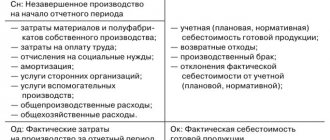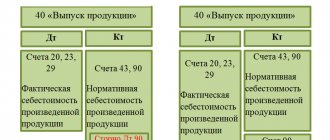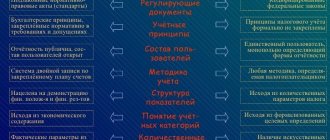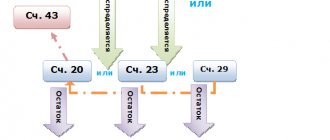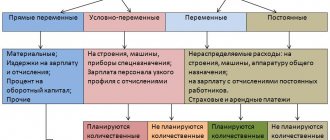Basic cost accounting methods
The efficiency of a company's activities can be assessed through proper accounting of current costs. The choice of cost accounting method is carried out by the organization independently by fixing the method in the accounting policy, taking into account current legal requirements. When regulations change, the company's accountant needs to make appropriate changes to the accounting. The main methods used by company accountants in the Russian Federation are the following:
- Regulatory - widely used in enterprises with mass or serial production, in manufacturing industries, in light industry, and mechanical engineering. Based on the use of specified standards.
- Process-based - most often used at power plants, in the mining or chemical industries, that is, where the range of products is narrow and semi-finished production is completely absent or limited. Allows you to accurately calculate each individual process.
- Custom - used in small-scale, individual production of complex products; for repair and experimental services. For example, these are shipbuilding and machine-building enterprises. The cost of each product is calculated based on direct and indirect costs.
- Transverse - common in mass production, which is characterized by sequential multi-stage processing of materials and raw materials. For example, these are the textile industry, the metallurgical industry, as well as chemical and oil refining. Calculation is carried out using the non-semi-finished method or the semi-finished method, with the calculation of cost at each limit (stage) of production.
Where is the process costing method used?
Typically, the process method is used at enterprises in the procurement and manufacturing industries.
Thus, it is clear when it is advisable to use the process method - when we are not talking about the final product that can be presented on the store counter.
The process-by-process method of cost accounting is logical to apply in industries that are characterized by the following conditions:
- relatively short technological cycle;
- absence (or small amounts) of work in progress;
- limited (one, two) range of products;
- costing items are homogeneous and close to cost elements.
The essence of the standard method of accounting for production costs
The peculiarities and concept of the normative cost accounting method are that the formation of normative cost estimates for products is carried out on the basis of norms developed in advance and valid at the beginning of a given period (usually a year according to methodological recommendations). In this case, absolutely all types of existing costs are taken into account according to the given values. Deviations of actual costs from current standards are reflected separately - the reasons (justifications) for such discrepancies, places and culprits are necessarily given. This is done in order to make appropriate changes to the calculations and determine the impact of indicators on the final cost of production.
In the process of manufacturing GP, the standard method of accounting for production costs uses the following formula:
Actual costs = Costs according to standards + Deviations from standards + Changes in standards.
As is clear from the names of the values, in order to calculate the actual cost, it is necessary to sum up the costs according to the established standards with existing deviations (both in the form of savings and overruns) and changes in indicators made during the period. It should be taken into account that the standards are laid down at the beginning of the period, and the calculation of products during the period is carried out based on the approved values. But if changes are made for various reasons, such a difference is subject to special accounting, and recalculation can only be done as of the beginning of the next year. All standard values are approved by the head of the enterprise or an authorized responsible person.
Deviations are determined in terms of direct costs. These are raw materials, materials, wages, wear and tear, etc. As for other indirect costs, the amount of deviations for them at the end of the month is distributed among all types of products. The disadvantage of this method is the impossibility of ongoing monitoring of production costs.
Basics of the cross-cutting method
The incremental method of accounting for production costs is used in industries where the final product can be obtained as a result of a sequential series of processing stages (for example, in the chemical industries), in each of which intermediate products (semi-finished products) are formed. For each processing stage, accounting of analytical cost indicators is organized. The final cost of the product is determined as the sum of the cost of the entire process.
Calculating production costs using this methodology consists of the following main steps:
- determination of production in physical terms;
- calculation of production in conventional units;
- summing up costs for all products;
- determination of costs per unit of production;
- division of costs between final products and unfinished products at the end of the period.
Basics of applying the process method of cost accounting and calculation
The essence of the process-by-process method of cost accounting and product calculation is that the cost calculation in an organization is carried out without breaking down into types of products, that is, with the determination of costing for the entire production process as a whole. In this case, both direct and indirect costs are not subject to distribution and are written off against the entire output of GP (finished products) under the relevant items. The object of accounting is not a specific product, but a production process, hence the name of the method.
No special formulas are used in the calculations, and the average cost of one product is determined by dividing the total costs incurred during the period by the number of units produced. If production has a long cycle, calculations are performed for each month, and the final cost is determined upon completion of the process. Administrative costs and those attributable to auxiliary production are accounted for under general operating items.
The use of this method is justified in those organizations where there are no semi-finished products, that is, unfinished products; homogeneous products are mass produced; The technological process is characterized by a short period. The nuances of the calculation vary depending on how many product items exist in production. If only one type of product is produced, the cost of one unit is calculated by simply dividing the total costs by the number of units.
If several different types of products are produced, costing is determined item by item, broken down by product, and total costs are distributed according to the accepted methodology. If there is a work in progress in production, WIP balances are taken into account according to the company’s valuation method at the beginning and end of the period, and current expenses for the month are adjusted according to the balance of work in progress.
Calculation is
Direct costing method
Used in companies with low fixed costs, with easily defined and quantifiable performance results. Russian accounting standards do not allow the full use of this accounting system for the purposes of preparing external reporting and calculating taxes. It is used in internal accounting to analyze and justify management decisions regarding break-even production and pricing.
This method is based on the calculation of the reduced cost of production and the determination of marginal income.
Need advice on your academic work? Ask a question to the teacher and get an answer in 15 minutes! Ask a Question
Using the custom method
The custom method of cost accounting and calculation is used to accurately determine the cost of certain types of products, as well as when carrying out equipment repairs and auxiliary work. The object of accounting in this method is not the type of product, but the order itself for a specified quantity of goods. The scope of application of the custom cost accounting method is individual production or small-scale production, consisting of the same range of products. If large products are produced in a long cycle, order calculation is performed not for the entire object as a whole, but for its parts - components, assemblies and other completed structures.
Example of a custom cost accounting method
Let's assume that a furniture manufacturing enterprise has released 2 orders in a month: the first includes 5 cabinets, the second 7 tables. Direct costs are equal: for the first order - 120,000 rubles, for the second - 50,000 rubles; indirect = 70,000 rub. There is no work in progress, let’s do the calculations:
- Total cost of 1 order = 120,000 + (70,000 x 120,000 / 170,000) = 169,411.76 rubles.
- Total cost of 2 orders = 50,000 + (70,000 x 50,000 / 170,000) = 70,588.24 rubles.
In the above methodology, the production cost of products was calculated with the distribution of indirect costs to the base for which direct costs were taken. But a method is also allowed when individual types of production costs are taken into account evenly by dividing by the entire number of products produced. In this case, the distribution of indirect costs will be the same.
Basics of Costing
Costing is the grouping of costs by accounting objects and the calculation of costs in terms of costing units.
Cost accounting is an analytical grouping of production costs in management accounts that provides the necessary information for costing. For these purposes, accounts 20-29 of the chart of accounts are taken into account.
Manufacturing cost accounting and costing methods are not regulated because the main objective of this cost accounting is to provide the management of the company with complete information about the costs and the ability to influence the results of the firm.
Calculation methods are divided into individual and mass. Individual methods include the order-by-order method of calculation, and mass methods include the per-distribution and process-by-process methods.
Features of the incremental method of accounting for production costs
The incremental method of cost accounting is the calculation of costs not by product, but by redistribution. It is used in industries with homogeneous raw materials. The object of cost accounting in the cross-cutting method is not the unit of product, but the individual phases of processing materials. And redistribution in the complex use of raw materials is recognized as a set of working technological operations, as a result of which an intermediate semi-finished product or already a semi-finished product is produced.
The procedure for using this method may vary in each organization depending on the method of reflection. What is common is that direct costs are formed for each processing stage; within different stages, products (semi-finished or finished) are combined into appropriate groups according to the degree of homogeneity of the raw materials and the complexity of their processing, and indirect costs are distributed according to the chosen principle. A decision is made independently on which processing stages and stages of production the cost is calculated, as well as which product items are included in each phase.
The basis for applying the incremental cost accounting method are two common options - semi-finished and unfinished. The first is characterized by determining the cost of semi-finished products at each stage of processing, which allows for more economically accurate calculation and control of the cost of finished products. In the second case, calculation of semi-finished products is not carried out, the cost of production is determined after release from production, and the movement of such objects is carried out between workshops in kind without making entries on accounting accounts.
Difference between semi-finished and semi-finished cost accounting methods
In accounting, the unfinished method of cost accounting is distinguished by the fact that products that have not undergone full technological processing, released from one stage, but used in the further production of GP, are not reflected in account 21, but are included in the work in progress in the account. 20. The internal movement of semi-finished products between workshops is controlled using data in physical terms, which are recorded by responsibility centers. During the calculation process, the cost of production is determined based on the total costs at all stages (redistributions) of production.
In contrast to the non-semi-finished method in accounting, the semi-finished method of cost accounting involves the initial entry of manufactured semi-finished products into the organization's warehouse and the subsequent write-off (transfer) of objects to other workshops for further use in the production of state enterprises. An account is used to reflect transactions. 21, and calculating the cost at each stage separately is necessary for the correct release of products. There are different options for calculating the unit cost - by the cost of inventories, by direct costs, by standard or actual, as well as accounting price. The optimal methodology is selected by the enterprise and enshrined in the accounting policy.
What the law says
Based on the Chart of Accounts (approved by order of the Ministry of Finance of Russia dated October 31, 2000 No. 94n), costs for production of products, performance of work or provision of services are reflected on accounts 20-39 of accounting in accordance with the procedure established at the enterprise.
At the same time, planning and accounting of all costs, as well as calculation of the actual cost of production, are carried out on the basis of certain methods of accounting for production costs.
Also see “Basic Manufacturing Cost Accounting Methods.”
Thus, the process-based cost accounting method can be used depending on:
• type of product;
• its complexity;
• type and nature of production.
In general terms, the process-by-process method for calculating the cost of products is described in the Methodological recommendations (instructions) of the Ministry of Industry and Science of Russia on planning, accounting and calculating the cost of products of the timber industry complex dated December 26, 2002. Despite the fact that this is an industry document, in fact it is relevant for all organizations.
Based on the completeness of cost accounting, the following methods are distinguished:
- Direct costing – in this method, costs are divided into fixed and variable. The cost price of a GP includes only variable costs - materials, raw materials, wages and general production variables (utilities, equipment maintenance costs, salaries of general shop personnel, etc.). Fixed costs not related to the production process are attributed directly to the financial result. The marginal method of cost accounting is used to regulate the volume of product output, analyze the workload of equipment, calculate sales prices and determine the minimum volume of GP output to cover current costs.
- The full cost accounting method consists of assigning all current production costs to the cost of products. With this method, direct and general production costs are directly written off to cost, and general operating costs are charged to costs without dividing them into types of products.
Current methods for calculating products were gradually developed and implemented at enterprises. The ancestor of modern calculations can be called the boiler method of cost accounting, which consists of summing up all costs incurred during a period into a common boiler. At the same time, neither the types of products produced nor the places where costs occurred were taken into account, which did not make it possible to determine the cost correctly and taking into account the characteristics of the manufactured products. Currently, this technique continues to operate only at those enterprises where one type of GP is produced and there is no need to calculate the exact cost.
The ABC cost accounting method is not widespread in Russia and is used mainly not for calculating costs, but for the purpose of financial analysis of the success of an enterprise. This method consists of calculating individual types of work (functions) with subsequent partial attribution to the price of the product. In this case, the entire technological process is divided into simple components with calculation of the consumed resources. Based on the results, all expended resources determine the final cost of the GP.
Accrual method
If an organization uses the accrual method, then income should be included in the calculation of the tax base for income tax in the period of their occurrence, and expenses - in the period to which they relate.
Documents can confirm the period of receipt of income or occurrence of expenses: contracts with counterparties, acts, etc. As a general rule, this should be done regardless of the actual receipt or payment of funds (clause 1 of Article 271, clause 1 of Article 272 of the Tax Code of the Russian Federation ).
Please note: the recognition of some income and expenses differs from the generally established rule.
So, for example, expenses for the purchase of raw materials and supplies used in the production of goods (works, services) are recognized on the date of transfer of raw materials and supplies into production and their use, and expenses for the purchase of tools, equipment, devices, and work clothes are written off as expenses for date of transfer into operation (clause 1, clause 5 of Article 254, clause 2 of Article 272 of the Tax Code of the Russian Federation). Let us recall that the rules for recognizing certain types of income and expenses using the accrual method are contained in Articles 271 and 272 of the Tax Code of the Russian Federation.
Also, expenses related to several reporting or tax periods are taken into account in a special manner. Such expenses must be distributed and written off in equal parts. The write-off period can be set, for example, based on the terms of the agreement with the counterparty (clause 2 of Article 271, clause 1 of Article 272 of the Tax Code of the Russian Federation).
Take advantage of all the features of Kontur.Externa
Send a request
The procedure for maintaining cost accounting using the actual method
Accounting according to the above methods of accounting for actual costs is carried out in two stages. The first stage involves the use of accounts 20, 23 and 29, which reflect direct production costs, as well as accounts 25 and 26, which are considered collective and distribution and take into account indirect (indirect) costs. The second stage consists of operations of uniform proportional distribution of indirect costs from accounts 25 and 26 to the cost of all types of products.
Thus, with the method of actual cost accounting, the following cost calculation algorithm takes place:
- Production costs are determined, distributed and written off;
- Business expenses are determined, distributed and written off;
- The cost of auxiliary products of own production is calculated;
- The costs of producing auxiliary products are distributed;
- The total amount of costs for the main production is determined;
- The amount of costs for work in progress is determined;
- The actual cost of production of the goods is determined;
- The costs of selling manufactured goods are distributed;
- The cost of the product is determined based on its sale.
